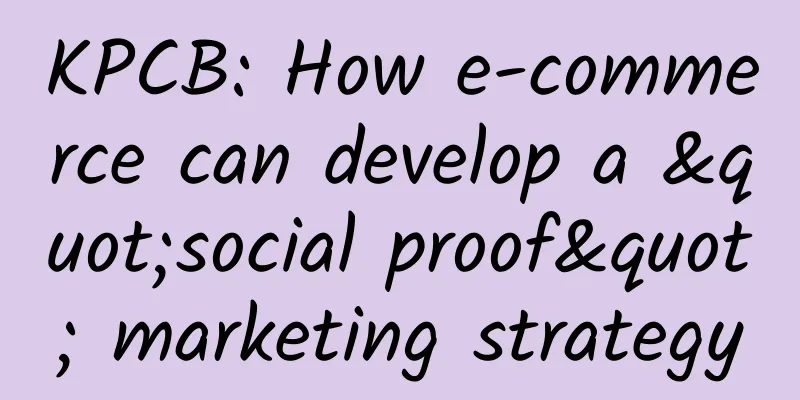KPCB: How e-commerce can develop a "social proof" marketing strategy

|
On November 28, 2011, Aileen Lee, a partner of venture capital firm Kleiner Perkins Caufield & Byers (KPCB), published an article on the well-known technology blog TechCrunch, introducing the "social proof" effect and strategy. Aileen Lee's investment focus is on consumer Internet companies. Some of the companies mentioned below have received venture capital from KPCB, such as One Kings Lane and Plum District (Aileen Lee is a member of the board of directors of these two companies). The following is an excerpt from the full article: We are in a period of rapid development of the "consumer Internet": despite the economic downturn, many web companies are growing rapidly. This situation reminds many people of the period more than ten years ago when companies such as Amazon, Netscape, eBay, Yahoo, Google and PayPal were founded. These companies face a not-new challenge—competing for consumer attention. If you’re looking to grow your user base, you may be wondering if there’s a single best, most cost-effective way to attract valuable users. I’m increasingly convinced that the best way to do this is to run marketing campaigns that leverage a concept called “social proof.” In the age of the social web, “social proof” remains a relatively untapped gold mine. What is social proof? In short, it is the positive impact that comes when someone sees that people are doing something. It is also called "informational social influence." Wikipedia defines social proof as “a psychological phenomenon in which people assume that the behavior of others reflects the correct behavior in a given situation… The phenomenon is driven by the assumption that people around them have more information about the situation.” In other words, social proof means that people will imitate the behavior of others; and this can be one of the biggest drivers of consumer behavior. Imagine a line of people waiting behind a velvet rope to get into a club. Most passersby would wonder why the club was so anticipated. The invitation-only system for Gmail, Gilt Groupe, Spotify, and Turntable.fm when they first launched was the digital version of the velvet rope, which helped them achieve viral growth. Professor Robert Cialdini, a leading social psychology thought leader, provides plenty of examples of this. In one study, his team tested the effects of various prompts on hotel guests’ reuse of towels. A social proof prompt—“Nearly 75% of other guests have used the same towel more than once”—was 25% more effective than all other messages. The effect was even better when the prompt was supplemented with “other guests who have stayed in this room.” In another study, a restaurant increased sales of a dish by 13-20% simply by saying, “This is our most popular dish.” Social proof also works in your subconscious mind, which is why comedy shows often add laugh tracks: When the audience hears other people laughing, they laugh more. Five types of social proof If you have a digital startup, the best way to get new users to know you is to cultivate and emphasize your social proof. Generating social proof for your products through social networks such as Facebook, Twitter, Google+, Tumblr, YouTube, and Pinterest can not only multiply the chances of people discovering your products, but also increase the impact of these products. You can think of it as laying the foundation for word-of-mouth to spread on a large scale. Here is an introduction to the classification of social proof and some savvy digital companies to measure its impact. 1) Expert social proof – Getting a recommendation from a credible expert, such as a magazine or blogger, can have an incredibly powerful impact. For example: On Rent the Runway, a premium fashion rental site, visitors who were referred by fashion magazines or bloggers converted 200% more than those who came from paid search. Klout is a service that identifies topic experts on the social web. It invited 217 design, fashion, tech and automotive “influencers” with high Klout scores to test drive the new Audi A8. These people generated 3,500 Twitter messages, which were broadcast to 3.1 million people in less than 30 days - a multiplier effect of more than 14,000 times. Plum District, a group buying site for moms, also taps into “moms with influence” who have high Klout scores. Customers referred by these “moms with influence” spend twice as much as customers from all other marketing channels. 2) Celebrity social proof - Up to 25% of TV ads in the US use the influence of celebrities, but so far only a few online startups have adopted celebrity endorsements. Some examples: In 1997, Priceline.com became one of the first web companies to use a celebrity endorsement. William Shatner (who played Captain James T. Kirk of the USS Enterprise in the American TV series Star Trek: The Original Series and its seven spin-off films) was not a travel expert, but his endorsement focused on helping consumers save money. It was a huge success. Priceline is now worth about $23 billion, and Shatner's shares are worth about $600 million today. Trendyol, Turkey’s fastest-growing fashion e-commerce company, regularly launches celebrity endorsement campaigns. This has helped it increase website traffic by 1.5 times and product sales by 30%. ShoeDazzle's chief designer is celebrity Kim Kardashian. With her help, the company achieved sales of $25 million in 2010, increased to $70 million in 2011, and recently raised $40 million in funding. Celebrities Jessica Simpson and beauty influencer Nerida Joy also recently helped Beautymint attract 500,000 visitors in its first 24 hours. The most “authentic” (and cost-effective) celebrity social proof is unpaid. In 2010, Gwyneth Paltrow’s unpaid mention of home decor site One Kings Lane on her blog GOOP led to a 90% increase in signups to the site (compared to the previous 4-day average). A viral campaign by music personality Sir Mix-A-Lot boosted Turntable.fm’s active users to 140,000 in just 4 weeks. 3) User social proof - Marketers on TV direct sales programs are good at sharing user success stories. Digital companies that have mastered this technique include: More than 61 million people visit Yelp every month to read user reviews (the company is about to go public). The reviews a company receives have a significant impact on their revenue. A recent Harvard Business School study showed that increasing a Yelp rating by one star can lead to a 5-9% increase in sales revenue. User-generated video (UGV) is an important social proof phenomenon. Early visitors to Shoedazzle watched an average of 9 UGVs, which led to a rapid increase in sales. UGVs on YouTube drove 3x the conversion rate for Beachbody (relative to general visitors). It’s also important to track the effects of negative user social proof. The first negative user review on eBay reduces a seller’s week-over-week growth from 5% to -8%; and every 1% increase in negative records leads to a 7.5% drop in sales price. 4) The wisdom of social proof of the crowd - Ray Kroc, the "Father of McDonald's", began to use the social proof effect in 1955. He put up a sign in McDonald's that said "1 million customers have been served", highlighting the popularity of McDonald's and its large number of customers, implying that "a million people can't be wrong". Here are some examples of web companies: Fashion e-retailer Modcloth used a “Be the Buyer” badge to let users vote for products they thought Modcloth should sell in the future. This had a big impact on shoppers: styles with the “Be the Buyer” badge sold twice as fast as styles without the badge. Callaway Digital Arts found that when a kids iPad app reached the top 10 of the iTunes App Store’s “Most Popular Apps,” it received 10 times more downloads per day than the week before. Being the #1 “Most Popular App” received 30-50% more downloads than the #2 app. Green tech company Opower cleverly used social proof to reduce electricity consumption. In its marketing emails, Opower compared a household’s electricity usage to that of their neighbors, which resulted in an 80% response rate. So far, this approach has helped users save 500 million kilowatt-hours of electricity. 5) The Wisdom of Social Proof from Friends - Following the lead of your social web friends may be the “killer app” for social proof, given its 1:1 influence and potential for viral growth. Some examples: Adopting a “friends invite friends” approach on Facebook and other social networks helped Zynga grow from 3 million average daily users to 41 million in just one year (from 2008 to 2009). Arguably the most valuable demographic on the social web is moms; they rely heavily on the advice of friends and family. Recent Babycenter research shows that moms rely on their friends’ opinions 67% more than other shopping demographics, and they rely on social media 243% more than the general population. · Customers who come through friend referrals are better. They spend more (on One Kings Lane, their lifetime value is 2x that of customers who come through all other channels); convert better (on Rent the Runway, their conversion rate is 75% higher than customers who come through other channels); and shop faster (on Trendyol, they sign up and make their first purchase twice as fast as customers who come through other channels) They are also better content contributors. People who saw content on TripAdvisor from their friends contribute twice as much content as others and are 20% more engaged than other users. Develop your social proof strategy Is there one social proof method that works best for your company? Maybe, but companies like LegalZoom have found that a mix of social proof methods is most effective. The beauty of the web is that you can quickly test, learn, and iterate to find what works best. It’s important to note that if you don’t build a great product that attracts customers and makes people like it enough to recommend it to others, then no social proof strategy will likely be effective. How do you know if you have a great product? You can track organic traffic growth, reviews, ratings and repeat usage, and measure your viral coefficient (if your site has sharing capabilities). What percentage of your visitors and users share information with others every day? How is the good word of mouth about your product spreading outside of your site? Do you know your Net Promoter Score and your Klout score? In the age of the social web, social proof is the new marketing. If you have a great product waiting to be discovered by users, you need to know how to create social proof for it, get it in front of the right "influencers", and get them to share information about it. Social proof is the best way to let new users know about your product, and the best way to convince existing users that they have made a wise choice. PS: Another psychological phenomenon, FOMO (Fear of Missing Out), is also a form of social proof. People not only imitate others, but also want to get things that are in short supply. FOMO has a great driving effect on shopping decisions, as can be seen from the rise of "flash sale" services. |
<<: Hitwise: French travel website rankings for the week ending November 19, 2011
>>: Cyber Monday: Evolution of Cyber Monday Promotions – Data View
Recommend
Paper straws forced me to quit even drinking milk tea. Who among my family members understands me?
What can make young people quit drinking coffee? ...
What are the effects and functions of Danshen injection? Is Danshen injection specifically used to treat it?
Salvia miltiorrhiza injection is a common injecta...
"Space rocks" found in the desert, subverting human understanding of the solar system?
Space rock could rewrite early solar system histo...
"Soft-hearted" consumption! Why are we easily sold?
Being a qualified salesperson is definitely a tec...
What is the medicinal value of immortal herbs?
There is a saying among the people that there is ...
The efficacy and function of ginger juice
I don’t know if you are familiar with ginger juic...
Half-moons, hangnails... Is there something wrong with your nails? Stretch out your finger and click in to check!
If you don't have half-moons on your nails, y...
Lufthansa: 2020 Asia Travel Industry Investment and Innovation Report
The PDF version will be shared on 199IT Knowledge...
The efficacy and function of sea daffodil
For the Chinese medicinal material such as sea da...
Anesthesia is like flying a plane? "General anesthesia" is not as simple as sleeping
Anesthesia technology is one of the important mil...
A 24-year-old boy contracted fungal pneumonia after smelling his unwashed socks! Are “stinky socks” so toxic?
Recently, a netizen named "Haiyan" from...









